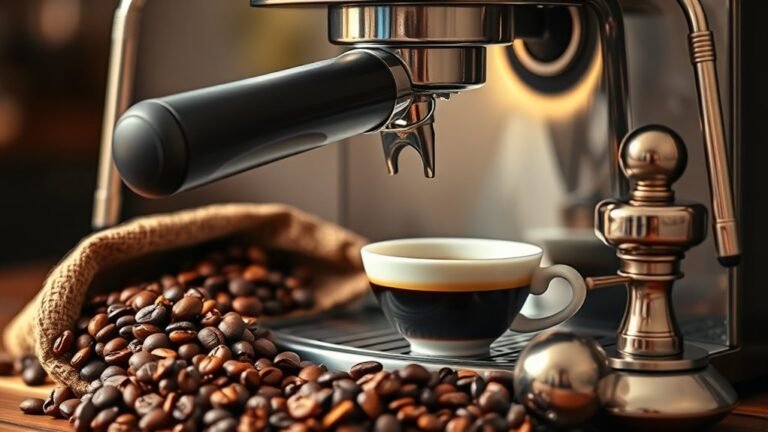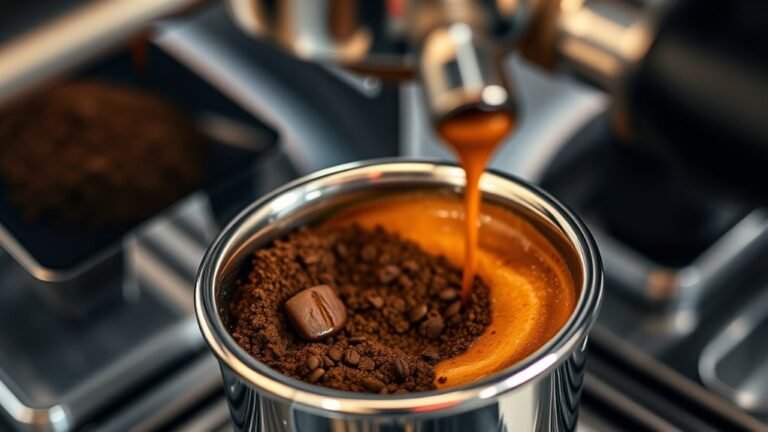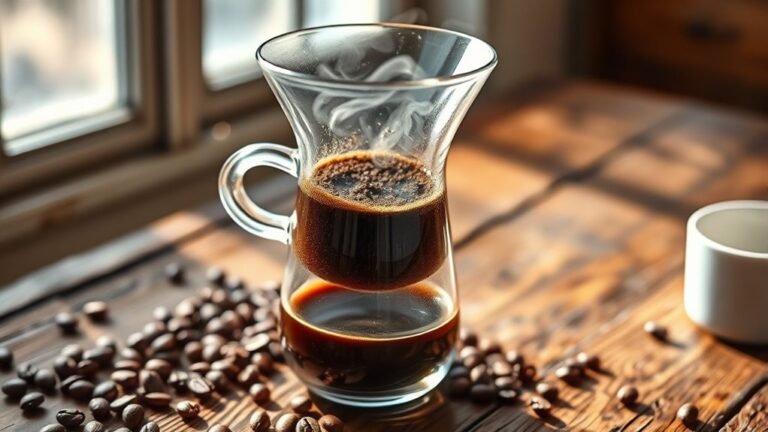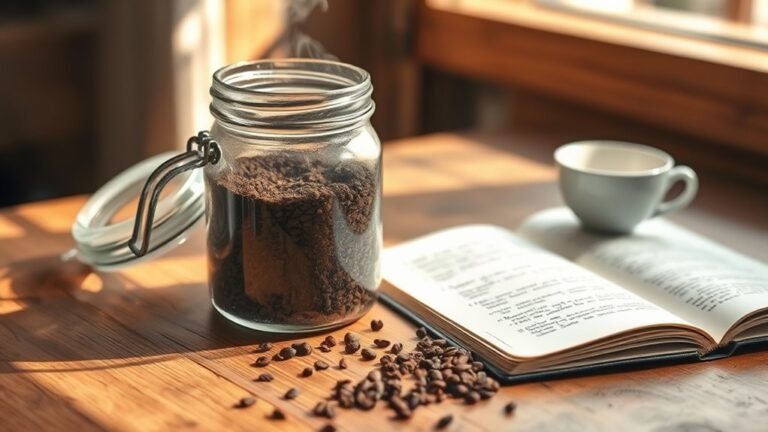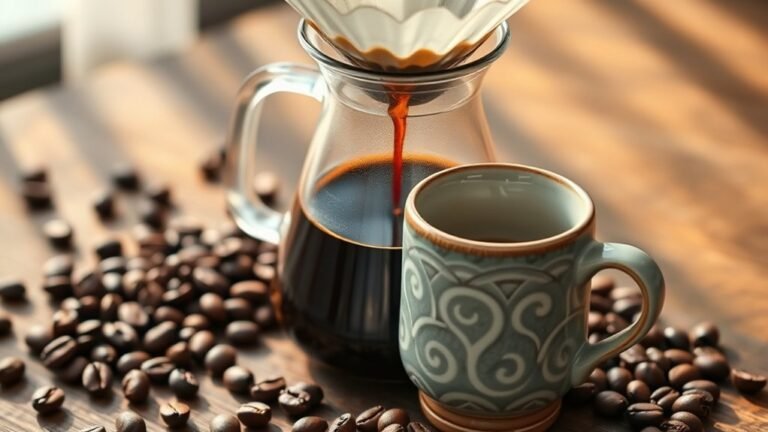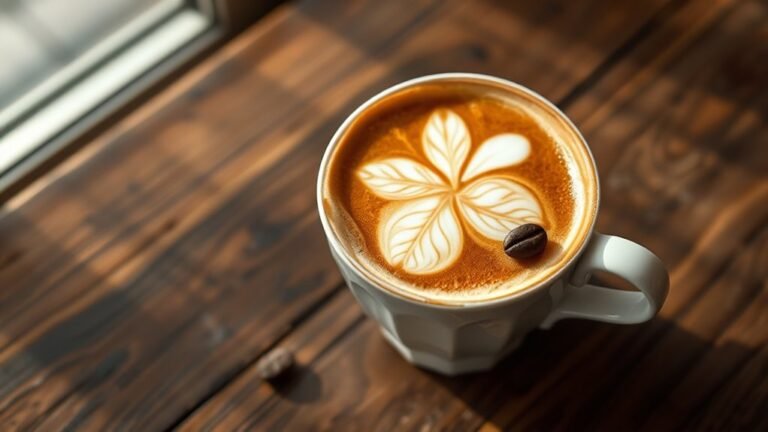The Importance of Water Temperature in Coffee Brewing
You need water temperature precisely between 90°C and 96°C to access your coffee’s fullest flavors without bitterness or sourness. Too hot, and you risk extracting harsh, bitter compounds; too cold, and the brew turns weak and underdeveloped. Water temperature directly influences acidity, sweetness, and body by controlling chemical solubility. Mastering this balance lets you tailor your cup to bean type and brew method, ensuring consistent quality. Explore the science behind this crucial brewing element to elevate your coffee experience.
Understanding the Role of Water Temperature in Extraction
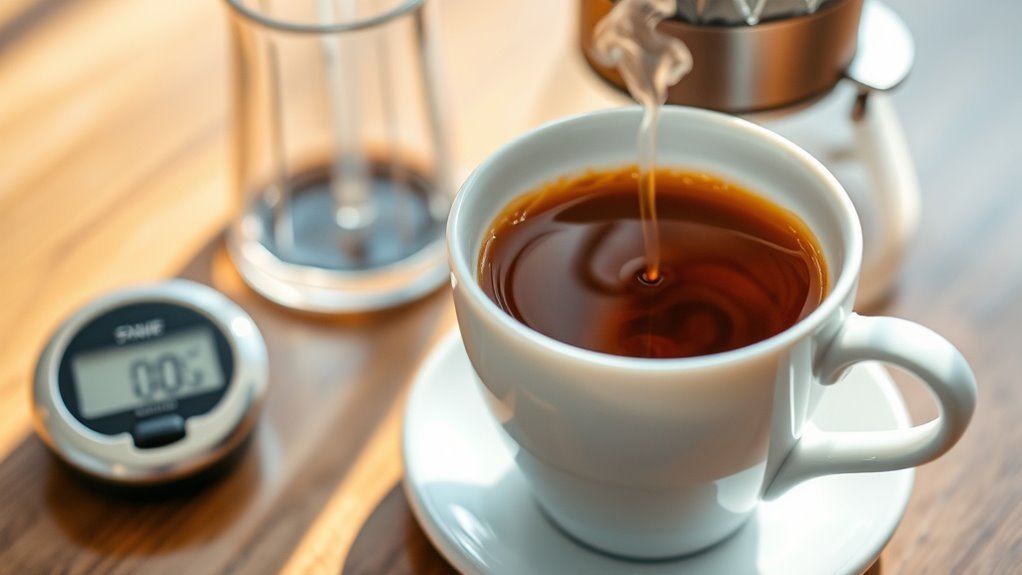
Although it might seem like a simple factor, water temperature plays a critical role in coffee extraction by directly influencing the solubility of coffee compounds. You need to understand that as water temperature rises, extraction efficiency increases, dissolving desirable flavors more effectively. Too low, and extraction suffers—resulting in underdeveloped, sour notes. Too high, and you risk over-extraction, pulling out bitter, harsh compounds. Mastering water temperature means controlling the chemical balance of acids, sugars, and oils that define your coffee’s character. When you adjust temperature precisely, you reveal the full spectrum of flavors, giving you freedom to craft a brew that resonates with your palate. Recognizing this relationship empowers you to elevate your coffee experience beyond mere brewing—into an exact science of taste.
Ideal Water Temperature Range for Different Brewing Methods
You need to tailor water temperature precisely to your brewing method to reveal the best flavors. Each technique demands a specific range—too hot or too cool, and you risk under- or over-extraction. Understanding these ideal temperatures is key to mastering the balance between acidity, sweetness, and bitterness in your cup.
Optimal Temperatures by Method
When brewing coffee, the ideal water temperature varies considerably depending on the method you choose, as each extraction process reacts differently to heat. For espresso machines, aim for 90–96°C to optimize pressure-driven extraction with precise brewing equipment. Pour-over methods, like V60, perform best between 92–96°C, balancing solubility and extraction time. Immersion methods such as French press thrive at slightly lower temperatures, around 90–94°C, to avoid over-extraction. Cold brew, of course, uses room temperature or chilled water, relying on extended steeping rather than heat. Remember, your water quality intertwines with temperature; even the perfect heat won’t compensate for poor water. By tailoring your water temperature to your brewing equipment and respecting water quality, you reveal the full potential of your coffee, empowering you to craft the cup that truly sets you free.
Temperature Impact on Flavor
Since water temperature directly influences the extraction of soluble compounds, it profoundly shapes your coffee’s flavor profile. Temperature variations alter how acids, sugars, and bitter compounds dissolve, impacting the balance and clarity of your brew. Understanding the ideal water temperature range for each brewing method lets you reveal specific coffee flavor profiles with precision.
- Pour-over: 195–205°F (90–96°C) for bright acidity and clarity
- French press: 200–205°F (93–96°C) to extract deeper body and richness
- Espresso: 190–200°F (88–93°C) to balance crema and intensity
- Cold brew: Room temp to cold water (68–75°F/20–24°C) for smooth, low acidity
Mastering these temperature ranges empowers you to craft coffee that truly expresses its potential, granting freedom in every cup.
Effects of Too Hot Water on Coffee Flavor
When your water temperature exceeds the ideal range, it accelerates extraction, pulling out bitter compounds that overpower the cup. You risk over-extraction, which diminishes the balance and complexity you seek. This intense heat can mask the subtle flavors that make specialty coffee truly exceptional.
Bitter Taste Development
Although brewing coffee with hotter water might seem like a quick way to extract bold flavors, it often leads to excessive bitterness that overwhelms the cup. When water temperature exceeds ideal ranges, it accelerates the release of bitter compounds that disrupt flavor balance. You’ll find that instead of nuanced notes, your coffee tastes harsh and one-dimensional.
Here’s what happens when water’s too hot:
- Bitter compounds extract rapidly, overshadowing delicate flavors
- Flavor balance shifts toward unpleasant sharpness
- Subtle aromatics are masked by aggressive bitterness
- The cup loses complexity, limiting your freedom to savor diverse profiles
Mastering temperature control guarantees you reveal coffee’s full potential without sacrificing smoothness or clarity. Avoiding overly hot water preserves that delicate equilibrium, so your brew remains vibrant and enjoyable.
Over-Extraction Risks
Pushing water temperature beyond the ideal not only triggers bitterness but also sets the stage for over-extraction, where compounds beyond the desired flavor spectrum flood your cup. Over extraction causes include excessively hot water accelerating the dissolution of undesirable bitter alkaloids and tannins. These compounds overshadow the coffee’s intrinsic sweetness and acidity, stripping away nuanced flavors you seek. Over extraction symptoms manifest as harsh, astringent notes that dominate your brew, leaving an unpleasant, dry mouthfeel. When you control water temperature precisely—typically between 195°F and 205°F—you prevent these adverse effects, preserving balance and clarity. Your freedom to craft coffee that’s vibrant and clean hinges on mastering this parameter. Avoiding over-extraction risks empowers you to release coffee’s full potential, ensuring every sip reflects deliberate extraction, not chemical overload.
Masked Coffee Nuances
If water temperature climbs too high during brewing, you’ll find that many subtle coffee nuances become obscured rather than highlighted. Excessive heat extracts compounds too aggressively, leading to masked flavor complexities that dull the coffee’s natural character. Instead of vibrant, nuanced taste profiles, you’re left with a flat, overly bitter cup. This happens because the delicate balance between acids, sugars, and aromatic oils is disrupted.
Consider these effects of too hot water on your brew:
- Loss of fruity and floral notes
- Amplified bitterness overshadowing sweetness
- Diminished clarity and mouthfeel
- Erosion of subtle spice and herbal undertones
To truly savor your coffee’s freedom of expression, maintaining an ideal water temperature is essential. It reveals the full spectrum of flavors without sacrificing precision.
Effects of Too Cold Water on Coffee Flavor
When water temperature falls below the ideal range for brewing, you’ll notice that extraction becomes incomplete, leading to a sour, underdeveloped flavor profile. Cold extraction slows the dissolution of essential coffee solubles, preventing the full spectrum of aromatic oils and acids from being released. This results in a muted, flat cup lacking complexity and depth. You’ll find that cold water fails to activate key compounds, leaving behind a brew that feels thin and unbalanced. If you’re chasing freedom in flavor, using water that’s too cold restricts your ability to access coffee’s full potential. Mastering temperature control empowers you to avoid the pitfalls of cold extraction and achieve a vibrant, nuanced flavor profile that truly expresses your coffee’s character.
How Water Temperature Influences Coffee Acidity and Bitterness
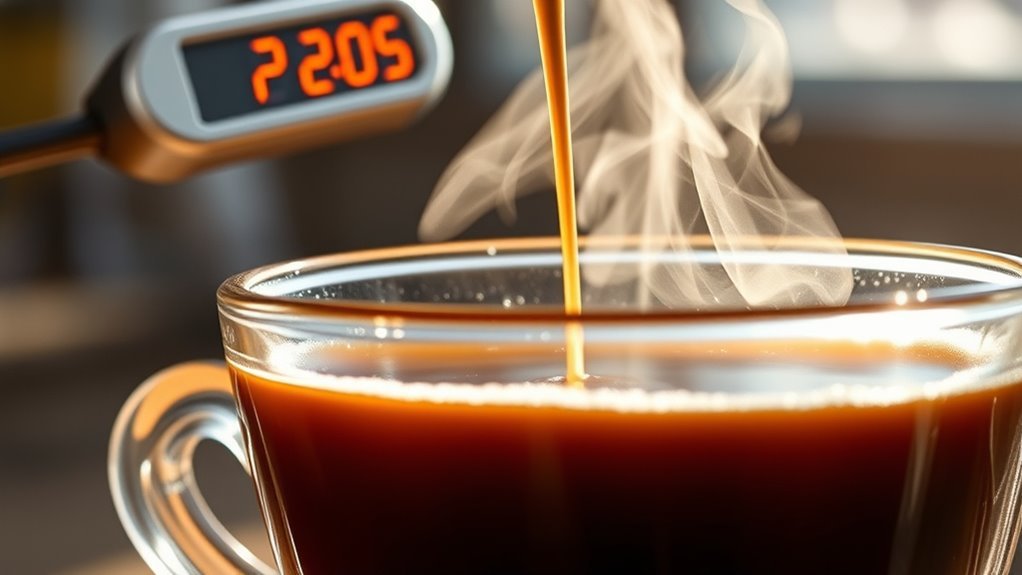
Although water temperature might seem like a simple variable, it plays a critical role in balancing coffee’s acidity and bitterness. When you control temperature precisely, you reveal the full spectrum of coffee acidity and bitterness, achieving ideal brewing balance. Too low, and the acidity dominates, leaving your cup sour and underdeveloped. Too high, and bitterness overwhelms, masking nuanced flavors.
Consider these effects of water temperature on coffee acidity and bitterness:
- Lower temperatures (below 90°C): Enhance coffee acidity but reduce bitterness extraction
- Ideal range (90–96°C): Achieves harmonious brewing balance, extracting both acidity and bitterness evenly
- Higher temperatures (above 96°C): Intensify bitterness, dulling the vibrant acidity
- Temperature fluctuations: Disrupt brewing balance, causing inconsistent flavor profiles
Mastering temperature control frees you to craft coffee that perfectly suits your palate.
Tools and Techniques for Measuring Water Temperature
Accurate water temperature measurement is essential for consistently brewing coffee at its ideal flavor profile. To achieve this, you must select the right thermometer types. Digital gauges are the most reliable, offering precise and rapid readings that empower you to maintain exact temperatures. Infrared thermometers provide non-contact measurement but can be less accurate with reflective surfaces. Analog dial thermometers, though less common, remain useful for their simplicity and durability. When measuring, immerse the probe fully in the water without touching vessel sides to avoid skewed results. Mastering these tools lets you control extraction variables, revealing your coffee’s full potential. By choosing the appropriate thermometer type and technique, you embrace the freedom to brew with consistency, precision, and confidence every time.
Adjusting Water Temperature for Different Coffee Bean Types
Mastering water temperature measurement sets the stage for tailoring your brewing process to the unique characteristics of different coffee beans. Each bean variety demands precise control over water temperature to reveal its full flavor potential. You’ll find that adjusting water temperature lets you highlight or soften specific flavor notes, ensuring a balanced cup every time.
- Light roasts benefit from water temperatures between 195°F and 205°F to preserve delicate acidity.
- Medium roasts thrive near 200°F, balancing sweetness and complexity.
- Dark roasts require slightly cooler water, around 190°F to 195°F, to prevent bitterness.
- Single-origin beans often need temperature tweaks based on their inherent density and moisture content.
The Science Behind Water Temperature and Solubility
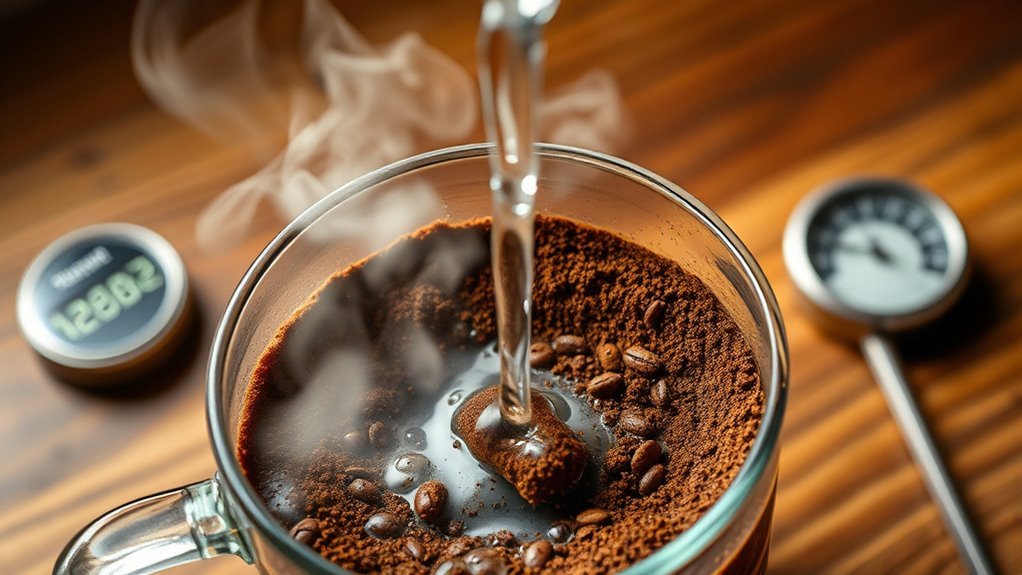
Because water temperature directly affects the solubility of coffee compounds, understanding this relationship is essential for extracting ideal flavors. When you control the temperature balance precisely, you influence how water chemistry interacts with coffee grounds. Higher temperatures increase solubility, dissolving oils, acids, and sugars more efficiently, while lower temperatures limit extraction, potentially causing under-extraction and muted flavors. It’s not just about heating water; it’s about achieving a delicate temperature balance that respects the chemical properties of your coffee. By mastering this science, you can reveal nuanced profiles and avoid bitterness or sourness caused by improper extraction. Embracing the exactness of water temperature transforms brewing from guesswork into an art, granting you freedom to craft a cup that’s both scientifically sound and passionately satisfying.
Tips for Maintaining Consistent Water Temperature During Brewing
Achieving the perfect extraction hinges on keeping your water temperature steady throughout brewing. Temperature stability directly influences flavor balance and consistency. To maintain this, you must optimize your brewing equipment and technique. Here’s how you can guarantee precise control:
- Preheat your brewing equipment, including the carafe and filter holder, to minimize heat loss.
- Use a temperature-controlled kettle or an electric kettle with variable settings to maintain consistent water temperature.
- Pour water steadily and evenly to avoid temperature fluctuations during extraction.
- Insulate your brewing vessel to reduce heat dissipation over time.
Common Mistakes Related to Water Temperature and How to Avoid Them
You might think boiling water is best, but it actually scorches your coffee, extracting bitter compounds. Brewing with water that’s too cold leaves your cup under-extracted and weak, missing critical flavors. To avoid these pitfalls, mastering precise temperature control and maintaining consistency throughout brewing is essential for peak taste.
Using Boiling Water
One critical mistake many coffee enthusiasts make is brewing with boiling water, which can greatly alter the flavor profile of your cup. Water at the boiling point (100°C/212°F) extracts undesirable compounds, resulting in bitterness and a burnt taste. Don’t fall for brewing myths that say hotter is always better. Instead, aim for a precise temperature just below boiling to reveal coffee’s nuanced flavors.
Avoid these boiling water pitfalls:
- Scalding coffee grounds, causing over-extraction
- Destroying delicate aromatic oils
- Accelerating bitterness and harshness
- Neglecting to let water cool slightly after boiling
Too Cold Brewing
Although brewing with water that’s too hot can ruin your coffee, using water that’s too cold poses its own set of problems. When you brew with water below the ideal range, extraction becomes incomplete, resulting in weak, underdeveloped flavors lacking complexity. This isn’t the same as cold brewing or ice coffee, which rely on extended steeping times and specific temperature control to draw out desirable compounds. If you try to shortcut by brewing hot coffee with water that’s too cool, you’ll miss essential oils and acids, leading to a flat cup. To maintain your freedom to experiment, understand that precise temperature control matters; cold water extraction isn’t a quick fix but a deliberate method. Avoid using water that’s too cold unless you intend to cold brew or make ice coffee properly.
Temperature Consistency Tips
Maintaining water temperature within the ideal range throughout the brewing process is key to achieving consistent coffee quality. Without temperature stability, your brewing techniques falter, leading to under- or over-extraction. Avoid these common mistakes to keep your coffee consistent:
- Don’t pour water immediately after boiling; wait 30 seconds to reach perfect temperature.
- Avoid brewing in cold cups or pots, which rapidly lower water temperature.
- Use insulated kettles or thermal carafes to maintain heat during brewing.
- Steer clear of reheating water multiple times, as it degrades temperature stability and taste.
Frequently Asked Questions
Does Water Temperature Affect the Caffeine Content in Coffee?
Yes, water temperature considerably influences caffeine extraction during brewing. When you control brewing temperature precisely, you optimize caffeine release from coffee grounds. Too low, and caffeine extraction is incomplete; too high, and you risk over-extraction, which affects flavor negatively. By mastering this balance, you gain freedom to tailor caffeine content in your cup exactly how you want, ensuring a satisfying, consistent brew every time.
Can Water Temperature Impact the Shelf Life of Brewed Coffee?
Ever wondered what truly affects your brewed coffee’s shelf life? Water temperature plays a subtle yet essential role. If the temperature’s too high or too low during brewing, it can accelerate oxidation and bacterial growth, shortening freshness. You want to preserve flavor and safety, right? By controlling water temperature precisely, you extend the shelf life, keeping your coffee vibrant and enjoyable longer—granting you the freedom to savor every cup without compromise.
How Does Altitude Influence the Boiling Point for Coffee Brewing?
When you’re brewing coffee at higher altitudes, the altitude impact on water’s boiling point is essential. As altitude increases, atmospheric pressure decreases, causing water to boil at a lower temperature. This means your coffee extracts differently because the boiling point is lower than at sea level. Understanding this lets you adjust your brewing parameters, ensuring your coffee’s flavor isn’t compromised. Embrace this knowledge, and you’ll brew with precision and freedom anywhere you roam.
Is It Better to Use Filtered or Tap Water for Temperature Control?
They say, “You can’t make a silk purse out of a sow’s ear,” and that’s true for your coffee water too. You’ll want filtered water over tap because its controlled mineralization guarantees consistent temperature stability and peak flavor extraction. Tap water’s unpredictable minerals can cause uneven heating, disrupting the delicate balance you need. By choosing filtered water, you’re liberating yourself to brew with precision, revealing the coffee’s full, nuanced potential.
Does Pre-Warming Coffee Equipment Affect the Final Brew Temperature?
Yes, pre-warming coffee equipment greatly stabilizes your brew temperature. When you pre-warm, you reduce heat loss caused by cold surfaces, ensuring consistent extraction. The benefits vary with equipment material—metal retains heat better than ceramic, so pre-warming metal gear optimizes thermal stability more effectively. By controlling this variable, you gain freedom to fine-tune flavor profiles, revealing the full potential of your coffee’s character with precision and passion.

